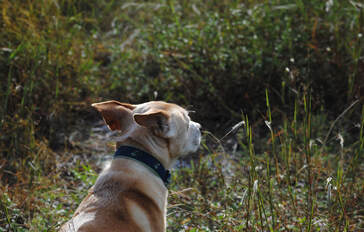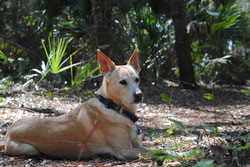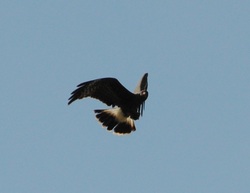
Sweet Shade
For Sandy Hound (2000 – 2015)
I remember the sweet shade.
Sandy hound scoops the bit of bark and tosses it, catching it in her paws as she did as a pup. Except now, the dirt’s on the blaze of her muzzle that’s showing more white than fawn. She gnaws the bark, cabbage palm worn smooth and the size of a small sea shell, then cradles it in her paws . . . Read More (The Coachella Review blog May 22, 2020)
For Sandy Hound (2000 – 2015)
I remember the sweet shade.
Sandy hound scoops the bit of bark and tosses it, catching it in her paws as she did as a pup. Except now, the dirt’s on the blaze of her muzzle that’s showing more white than fawn. She gnaws the bark, cabbage palm worn smooth and the size of a small sea shell, then cradles it in her paws . . . Read More (The Coachella Review blog May 22, 2020)

Coffee Break
Whole Terrain Aug. 17, 2016
Under the palmetto overgrown back against the fence, I drink my coffee. Loyal hound mutt Sandy lies beside me.
She’s unsteady now on her feet—that’s the medicine. Phenobarbital, strong stuff. She lifts her white-striped muzzle, sniffing the air and looking toward the early light. We’ve got some time, a little time, so we stay here and receive the day’s warmth . . . Read More
Whole Terrain Aug. 17, 2016
Under the palmetto overgrown back against the fence, I drink my coffee. Loyal hound mutt Sandy lies beside me.
She’s unsteady now on her feet—that’s the medicine. Phenobarbital, strong stuff. She lifts her white-striped muzzle, sniffing the air and looking toward the early light. We’ve got some time, a little time, so we stay here and receive the day’s warmth . . . Read More

To Flat-lands, Remembering a Forgotten Artist
Concho River Review, Spring 2015 issue |
 Sugar Mule Journal, Issue 39 Sugar Mule Journal, Issue 39
In Peril: An Essay on the Everglades Hawk
About four miles out, on the edge of the slash pines, I saw a shadow approaching from overhead, and I looked up. The bird was black, soaring like a vulture, but it was flying quite low and then it beat its wings—a movement too swift and erratic for a turkey vulture. I captured four photos of the bird in flight before I realized it had a snail, about the size of a golf ball, in its hooked bill. It was a male Everglades Snail Kite, one of several threatened bird species that had once thrived in the marshes and swamps of South Florida ... Read More. (Sugar Mule Journal, Issue 39) |
Encounters with a Ghost
Two birds bob down for insects, long, slender bills turning over the rich marsh soil. Night seeps in, and coldness, colder than the nights before. Instinct prepares them for the beginning of a journey, the long flight east to coastal Canada for one final rest in Labrador before three days of nonstop flight. Due South-southeast, then straight south, two thousand miles over the open ocean, nothing but water and sky.
The Eskimo Curlew is a powerful flier, fattening up on blueberries and insects every August before flying to South America. Every year, this arctic shorebird makes a 20,000-mile roundtrip migration from tundra to wintering ground in Argentina and Uruguay—across Canada and then south over the Atlantic Ocean. The Eskimo Curlew, which up until the 1870s was one of the most common shorebirds in North America, has a soft, melodious call: tee tee tee or tee dee tee dee. It is slightly larger than a pigeon, has a slender, down-curved bill, and stands on long, stilted legs ... Read More. (EarthSpeak Magazine, Issue No. 3, Spring 2010)
Two birds bob down for insects, long, slender bills turning over the rich marsh soil. Night seeps in, and coldness, colder than the nights before. Instinct prepares them for the beginning of a journey, the long flight east to coastal Canada for one final rest in Labrador before three days of nonstop flight. Due South-southeast, then straight south, two thousand miles over the open ocean, nothing but water and sky.
The Eskimo Curlew is a powerful flier, fattening up on blueberries and insects every August before flying to South America. Every year, this arctic shorebird makes a 20,000-mile roundtrip migration from tundra to wintering ground in Argentina and Uruguay—across Canada and then south over the Atlantic Ocean. The Eskimo Curlew, which up until the 1870s was one of the most common shorebirds in North America, has a soft, melodious call: tee tee tee or tee dee tee dee. It is slightly larger than a pigeon, has a slender, down-curved bill, and stands on long, stilted legs ... Read More. (EarthSpeak Magazine, Issue No. 3, Spring 2010)
